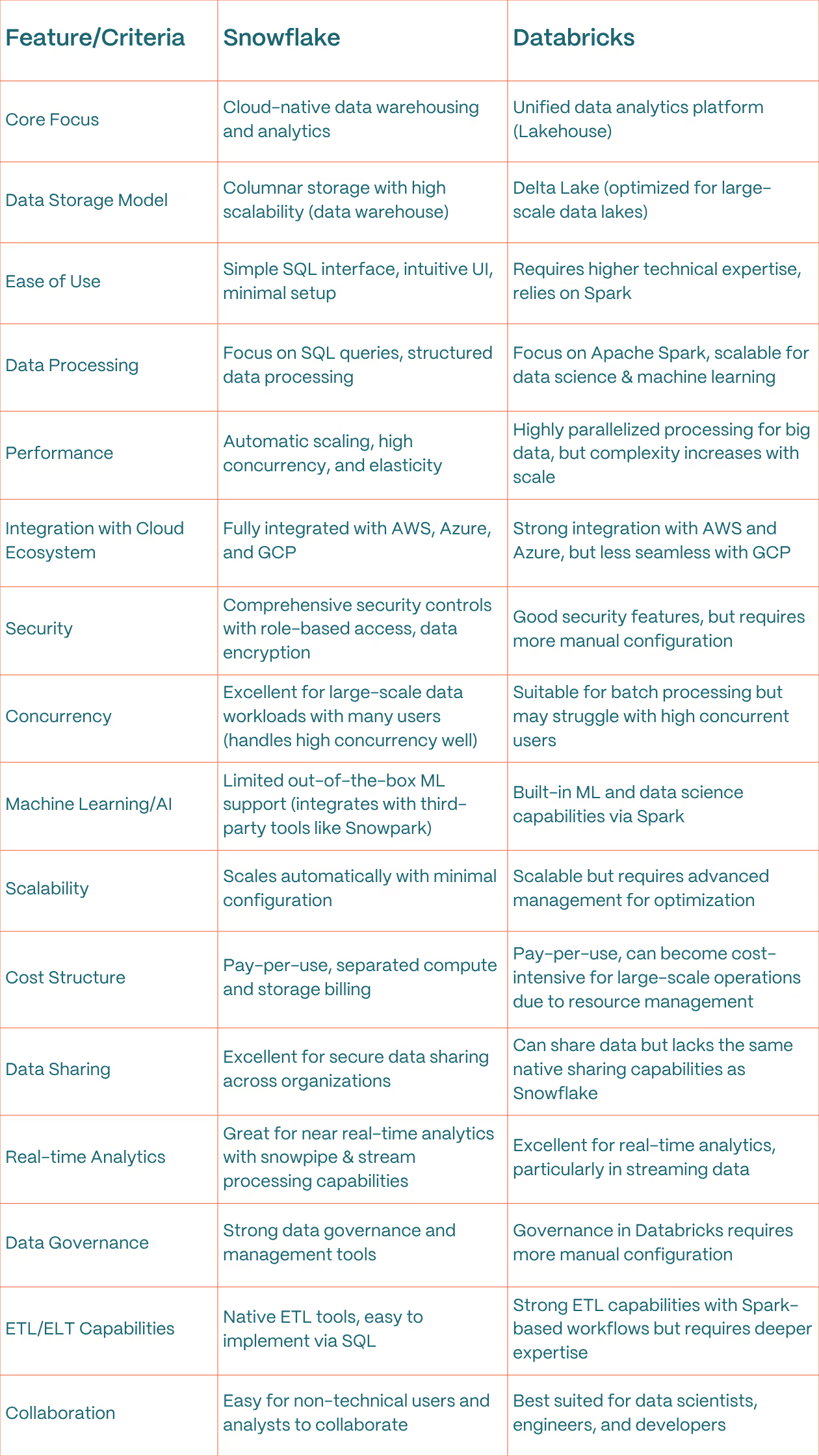Snowflake vs. Databricks: A Deep Dive into Modern Data Engineering Architectures
The blog aims to demystify the complexities of today’s data engineering landscape by providing an in-depth exploration of advanced data architectures, pipelines, and analytics.

This blog will focus on the practical applications and comparative advantages of leading cloud-native platforms, namely, Snowflake and Databricks - Illustrating how they are redefining scalability, performance, and cost-efficiency in data management. Through clear explanations, detailed case studies, and actionable best practices, the objective is to empower data professionals, IT leaders, and business strategists to transform raw data into strategic assets, optimizing modern data workflows to drive innovation and competitive advantage.
Need:
In an era where data volumes are exploding and business dynamics are evolving rapidly, organizations face the dual challenge of managing massive datasets while extracting meaningful insights in real time. The need for modern data engineering has never been greater—especially as enterprises transition to cloud-based solutions that promise enhanced agility and scalability. Platforms like Snowflake and Databricks offer transformative capabilities, from automated data warehousing and real-time analytics to robust machine learning integration, yet leveraging these tools effectively requires a deep understanding of their nuances. This blog addresses that critical need by breaking down intricate concepts and providing a clear roadmap for implementing these advanced technologies, ensuring that organizations can navigate the complexities of data engineering to achieve operational excellence and drive strategic decision-making.
Introduction:
In today’s digital age, data is the lifeblood of innovation and decision-making, making modern data engineering an indispensable discipline. In this blog, "A Comprehensive Analysis and Decoding for Modern Data Engineering" we embark on a deep dive into the sophisticated world of data management and processing. We'll explore how organizations are transforming raw, disparate data into valuable insights, and how cutting-edge tools, techniques, and architectures are reshaping the data landscape.
A key component of this analysis is a detailed comparison between leading platforms such as Snowflake and Databricks. We'll examine how Snowflake's cloud-native data warehousing capabilities and ease of integration contrast with Databricks’ unified analytics approach, designed to accelerate big data and machine learning workloads. By decoding the strengths and trade-offs of each, our goal is to provide actionable insights that empower data professionals to choose the right tools for their unique business challenges.
Whether you are an experienced data engineer or new to the field, this blog aims to demystify the latest trends, unravel complex data engineering architectures, and offer a clear roadmap for leveraging modern technologies to drive your organization’s success.
Comprehensive Analysis: Snowflake vs. Databricks for Modern Data Engineering
In the world of modern data engineering, two platforms that have captured significant attention are Snowflake and Databricks. Both offer robust solutions for data storage, processing, and analytics, but they cater to different use cases, offering strengths and weaknesses based on the nature of data operations, business needs, and scalability requirements.
Comparison Table: Snowflake vs. Databricks for Modern Data Engineering

Conclusion
After a detailed analysis, it's clear that Snowflake holds a clear advantage for most businesses, especially those focusing on ease of use, scalability, and seamless integration with cloud ecosystems.
Here's why Snowflake is the best choice:
User-Friendly Interface: Snowflake’s simplicity with SQL queries and a straightforward, cloud-native architecture makes it accessible even to teams without deep engineering expertise. The intuitive UI ensures non-technical users and analysts can leverage its powerful features with minimal learning curve.
Seamless Scalability: Snowflake's ability to scale compute and storage independently is a game-changer, offering businesses the flexibility to scale resources on-demand without complicated configurations. This makes it an ideal solution for businesses of any size, ensuring performance is always top-notch without overpaying for unused resources.
Strong Security and Data Governance: Snowflake offers robust security features, including automatic encryption, and advanced role-based access controls, which are crucial for industries handling sensitive data. Snowflake’s automatic compliance with global standards further strengthens its security posture.
Cost-Effective: Snowflake’s pay-per-use model with separate compute and storage billing ensures that businesses only pay for the resources they use. Unlike Databricks, which can incur higher operational costs with large-scale Spark clusters, Snowflake provides predictable pricing with automatic scaling.
Exceptional Data Sharing Capabilities: Snowflake’s unique data sharing architecture allows businesses to securely share data across different organizations, a key factor for modern data ecosystems. This built-in data-sharing capability stands as a significant differentiator over Databricks, which lacks this level of integration.
Optimized for Data Warehousing: While Databricks excels in large-scale data science and machine learning workloads, Snowflake is far superior when it comes to traditional data warehousing and analytics. Its columnar storage and SQL-centric architecture make it the gold standard for managing structured data.
In conclusion, for companies looking to leverage modern data engineering at scale, with minimal complexity and high performance, Snowflake is undeniably the best choice. Its versatility, ease of use, security features, and cost-effective scalability make it the ideal platform to support data-driven decision-making, ensuring businesses are empowered to unlock the full potential of their data without compromising on security or performance.

.jpg)
